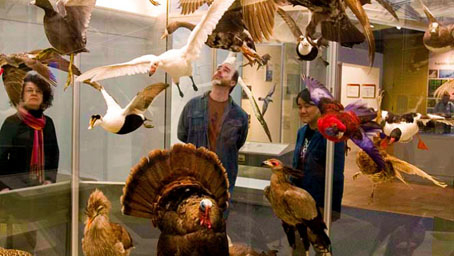Museums, stories and things.

Hi there!
No, wait. If I’m going to be the resident Australian here at the ROM for the next month I suppose I should ham it up some.
Let me try again.
G’day! I’m Maxine and I’ll be taking over part of the ROMs airwaves for the next few weeks writing as the Digital Communications intern. I’m from Sydney and am employed as a Project Coordinator in Research and Collections at the Australian Museum which I love. I’m also a Master of Museum Studies (Yes, that’s a thing) student at the University of Sydney and I’m at the ROM for a month as part of that degree. Each day I’ll be writing about what I discover about the Museum from inside it. Over the next four weeks you’ll get a unique look at this great Museum, its exhibitions, people, research and objects, from one who is usually very much outside of it.
I’m fascinated by museums. They’re wonderfully complicated and vibrant places to work. They’re warren-like and rarefied and like all interesting places, a lot of the great bits are hidden from view or hard to find. For me, the collections of museums are their backbone. The objects in these collections are more than dusty old bits of the past, they are mysterious, history-laden and continuously changing “things.”
Let me explain what I mean. A couple of years ago I worked at a small gallery in Kings Cross in Sydney. Though I’d always been captivated by objects and our relationships with and to them it wasn’t until this time that I really got to experience how important and fulfilling our relationship to ”things” can be. I worked on an exhibition of photographs, mostly of indigenous people, taken in the early 20th century. One of the photographs in the exhibition showed a family on a horse and cart and the curator had managed to locate and contact the descendants of this family. They came across country to attend the exhibition opening. It was a truly moving experience to just be in the room with these people as they stood in this room with this object, a photograph that suddenly took on so much personal history and meaning.
It was not my moment and their story is not mine to tell, but it really revealed to me in a very simple and poignant way how much physical “things” are so integral to how we express our lives. We are connected to them, they reflect us and we reflect them. It seems obvious but it’s easy for us to forget these “things” as we go about the daily business of being alive. Who among us stops to think about the design, manufacturing and philosophical history embodied in a dress? Or even how the birds we watch in the park or at our shores might be able to tell us something about the effects of climate change? It’s museums like this one, by collecting, researching and exhibiting these “things,” that set them outside of our day-to-day and make it possible for us to really look at them. In doing this, we can see the story and deepen our experiences of our lives as part of that long and complex chronicle of history and nature.
I’m really looking forward to having the chance to get deep inside the belly of the ROM to meet some of these “things” that tell us who and how we were a long time ago, who and how we are now and who and how we are in sync with our environment and the planet itself.
So stay tuned and I hope to see you around these interwebs. You can follow me on Twitter @museophiliac or email me at maxinek@rom.on.ca
